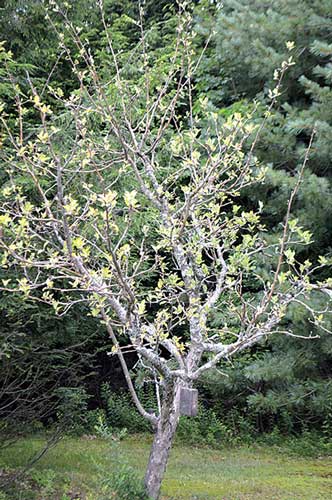 |
| An apple tree showing signs of stress – possibly Rapid Apple Decline. English photo |
By C.J. Walke
In March of this year, numerous reports of apple tree die-off populated the news with titles such as “Across America, Apple Trees are Dying, and Scientists Don’t Know Why” and “Something is Killing Our Apple Trees, and No One Knows Why.” Reports of apple trees “mysteriously” dying in recent years have been coming from Northeastern and Northwestern states as well as Ontario, Canada. Researchers at the Pennsylvania Department of Agriculture have named the phenomenon Rapid Apple Decline (RAD), or Sudden Apple Decline (SAD), and an explanation has yet to be found.
Symptoms of RAD resemble characteristics of stress, in which leaves begin to look pale yellow, then reddish, which often indicates girdling, and then curl up and eventually die. Whole limbs or whole trees can be affected. One commonality among affected trees, at least in dwarf rootstock plantings, seems to be tissue necrosis starting at the graft union and spreading up the tree, while the rootstock can still be healthy and suckering. The graft union typically shows severe shedding of bark and formation of cankers.
Most research on RAD is being conducted by PennState Extension, led by Kari Peter, Ph.D., assistant professor of tree fruit pathology, who first discovered the decline in 2013. To date potential causes (fire blight, Phytothphora, virus, insects, drought) have been isolated and researched, but no common thread has been found. I expect to hear more about this significant phenomenon in coming years.
Cumulative Effects of Drought
The cumulative effects of drought on fruit trees in general are also being discussed in the Northeast. After three consecutive years of drought conditions in Maine, the current year excluded, trees have been showing signs of water stress that seem to build over time and have consequences that are not immediately apparent. I have heard many reports of fruit trees dying this season, without an obvious reason.
Cumulative years of drought stress can weaken the overall defense system of a tree, making common insect or disease damage potentially lethal. As with most organisms, when the health of a tree is compromised, it becomes far more susceptible to attacks. This may be what is happening this season. Weakened trees can also be more susceptible to winter injury or shoot dieback, which becomes evident in the spring.
We believe we are seeing signs of cumulative drought on fruit trees in the older orchards at MOFGA’s Common Ground Education Center. The site is mostly a very well-drained Madawaska fine sandy loam. We typically do not irrigate established trees, although newly planted trees are usually watered for the first two seasons in the ground. We have planted a variety of fruit trees on the grounds, and most of the apples are standard trees on Antonovka rootstock, which should be vigorous enough to seek adequate water in dry times.
Weakened health on some of our older trees has been tough to diagnose, even by growers with decades of experience with organic fruit trees. When you visit the Common Ground Country Fair this September 20, 21 and 22, walk through the older orchards and look for yourself, or join one of the orchard tours during the Fair, where we’ll discuss common issues with organic fruit tree cultivation as well as some of the more difficult-to-manage issues discussed in this article.
Thank you to pomology experts at UMaine’s Highmoor Farm for adding insight for this article through personal email correspondence. For more information, see “Apple Disease – Rapid Apple Decline (RAD) or Sudden Apple Decline (SAD)?” by PennState Extension.
C.J. Walke is MOFGA’s organic orchard educator and farm manager at College of the Atlantic. You can contact him at [email protected].
